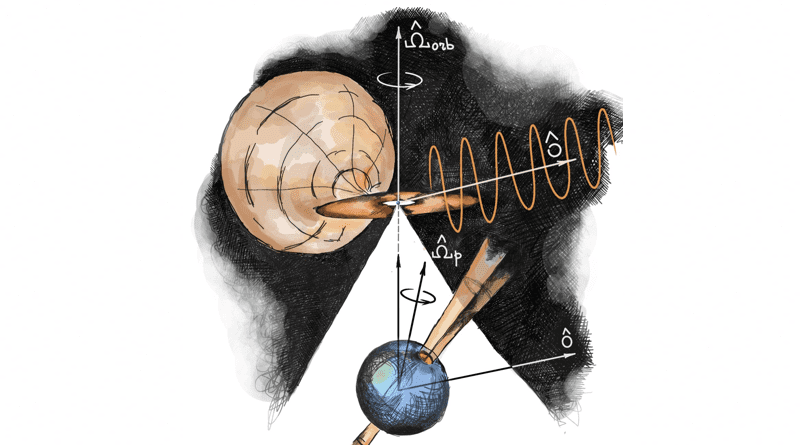Wobbling Like A Spinning-Top: Surprising Observations Of X-Ray Pulsar
An X-ray pulsar is a rotating magnetized neutron star. The very first direct measurement of the polarization of an X-ray pulsar by the Imaging X-ray Polarimetry Explorer (IXPE) space telescope has challenged previous models of such systems. The degree of polarization of the X-ray pulsar Hercules X-1 was much lower than theoretically predicted, so astrophysicists are now having to reconsider their basic ideas about the geometry and structure of matter flows.
According to the new findings, the axis of rotation and the magnetic axis of the neutron star, as well as the direction of angular momentum in this binary star system, are not – as expected – aligned, so that the object wobbles like a spinning top. A big international team of researchers has published these curious findings in the journal Nature Astronomy. The lead authors are Dr. Victor Doroshenko of the Institute of Astronomy and Astrophysics at the University of Tübingen and Dr. Juri Poutanen of the University of Turku in Finland.
X-ray pulsars have diameters of only about ten kilometers, but they are heavier than our Sun and have a magnetic field that is several billion times stronger than any magnetic field we know on Earth. They form a binary star system with a normal star, which allows matter to overflow into the polar regions of the pulsar via a magnetic field – as if through a funnel. This releases immense energies and makes X-ray pulsars very bright in the X-ray sky.
Rethinking previous models
Now the IXPE mission, launched earlier this year, is providing a new perspective on these pulsars. IXPE is the first pioneering mission to measure polarized X-rays from celestial objects. “Her X-1 was the first X-ray pulsar observed by IXPE. We were very surprised that only low polarization was observed. That threw off our theoretical predictions. We don’t understand it yet,” says Victor Doroshenko. The average degree of polarization of about 8.6 percent – measured with high precision by IXPE – was much lower than the expected roughly 80 percent predicted by theoretical work, he says.
“Such a large discrepancy indicates that we have to fundamentally reconsider our previous models of radiative transfer in strongly magnetized plasmas accumulating at the poles of neutron stars, as well as our ideas regarding the geometry and structure of the emission region in Her X-1 – and probably other pulsars,” adds Yuri Poutanen.
“I have studied Her X-1 for most of my life, and it continues to surprise me,” says one of the study’s co-authors, Professor Rüdiger Staubert of the Tübingen Institute for Astronomy and Astrophysics. “It is the first X-ray pulsar for which we have been able to directly measure the magnetic field of the neutron star. And it is one of the most studied objects of its kind. But we are still far from fully understanding it,” Staubert says.
Final proof pending
Despite all the new puzzles, the research team is excited about the results.
“For the first time since the discovery of X-ray pulsars five decades ago, it was possible to measure the angle between the axis of rotation and the magnetic dipole axis by studying the changes in the polarization angle with the phase of proper rotation. We need this information to model emission from such objects,” Doroshenko explains. “We combined these X-ray polarimetric observations with earlier optical polarimetric measurements. Thus, we were able to prove that the axis of rotation of the pulsar is not aligned with the orbital angular momentum. This suggests – as do other earlier observations – that the neutron star is wobbling like a slowing spinning-top.”
The ultimate proof is expected later this year, when IXPE is scheduled to observe the X-ray pulsar Her X-1 in another phase of its 35-day cycle, according to Professor Andrea Santangelo of the Tübingen Institute for Astronomy and Astrophysics. “IXPE is just now starting the new observational window of X-ray polarimetry and paving the way for the next generation of X-ray polarimeters. This is just the beginning of a great adventure,” he adds.
The Imaging X-ray Polarimetry Explorer (IXPE) was launched from Cape Canaveral earlier this year aboard a Falcon 9 rocket and is now orbiting 370 miles (600 kilometers) above the Earth’s equator. The mission is a collaboration between NASA and Agenzia Spaziale Italiana with partners and scientists in twelve countries. The space mission is controlled by Ball Aerospace, which is based in Broomfield, Colorado, USA.

